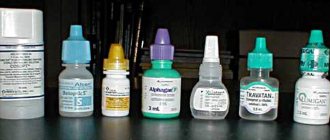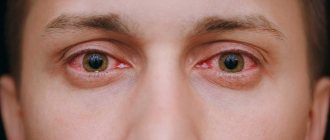Pharmacodynamics and pharmacokinetics
Pharmacodynamics
Chemically, levofloxacin is the L-isomer of the racemate of the drug Ofloxacin . the L-isomer of Ofloxacin that has an antibacterial effect .
An antibacterial agent from the pharmacological group of fluoroquinolones , inhibits the activity of type 2 topoisomerase DNA gyrase and topoisomerase of bacterial cells. The action in the cells of gram-negative microorganisms is directed mainly at DNA gyrase , and in gram-positive microorganisms - at topoisomerase of the fourth type.
Active against gram-negative aerobes : Haemophilus influenzae, Branchamella cataralis, Neisseria gonorrhoeae and Pseudomonas aeruginosa; gram-positive aerobes : Streptococcus pneumoniae, Streptococcus pyogenes, Staphyloccocus aureus.
Pharmacokinetics
After use, levofloxacin is well fixed in the tear film. Typically, the average concentration in the blood 60 minutes after use ranges from 0.86-2.05 ng/ml.
The highest concentration of levofloxacin in the blood is recorded on the fourth day after two days of using the drug eight times a day.
Instructions for use OFTAQUIX
Antibacterial drug for local use in ophthalmology. Levofloxacin is the levorotatory isomer of the racemic mixture of ofloxacin. The antibacterial activity of ofloxacin is predominantly due to the levorotatory isomer. The mechanism of action of the drug is due to the action of DNA-DNA gyrase and topoisomerase IV on the complex.
According to preliminary data, the MICs that distinguish sensitive pathogens and microorganisms with intermediate sensitivity from resistant ones are a maximum of 2 mg/l for sensitive ones, and a minimum of 8 mg/l for resistant ones.
The prevalence of acquired resistance among individual species of microorganisms may vary in different geographic regions and at different times; It is desirable to have data on resistance in a specific region, especially in cases of severe bacterial infections. Thus, the information presented is of a general advisory nature regarding the probable sensitivity and resistance of microorganisms to levofloxacin.
Data are provided on the activity of the drug against those types of bacteria that most often cause superficial eye infections.
Sensitive microorganisms include
aerobic gram-negative: Branhamella (Moraxella) catarrhalis, Haemophilias influenzae, Neisseria gonorrhoeae, Pseudomonas aeruginosa; aerobic gram-positive: Staphylococcus aureus*, Streptococcus pneumoniae, Streptococcus pyogenes; others:
- Chlamydia trachomatis.
* - applies only to methicillin-sensitive strains of Staphylococcus aureus. Most methicillin-resistant strains of Staphylococcus aureus are also resistant to fluoroquinolones.
Organisms are classified as resistant to levofloxacin based on in vitro susceptibility testing and plasma concentrations following systemic administration. When applied topically, maximum concentrations in the eye are higher than in plasma. However, it is unknown whether and how exactly the kinetics of this drug when applied topically affects the antibacterial activity of levofloxacin.
Cross-resistance between fluoroquinolones is possible if it is caused by mutations in bacterial topoisomerases. Single mutations may not cause clinical resistance, but multiple mutations usually always lead to clinical resistance to all drugs of the same class. If resistance is due to a violation of the penetration of the active substance, the mechanism of its elimination, or a combination of both, the sensitivity to different fluoroquinolones may be different. It is determined by the physicochemical properties of various drugs of this class and the affinity of the carrier systems.
Side effects
- most often occur: a burning sensation in the eye area, decreased visual acuity, identification of mucous strands;
- less frequently appear: blepharitis , growths in the form of papillae on the conjunctiva, swelling of the eyelids, chemosis , discomfort in the eye area, pain or itching in the eye area, development of follicles on the conjunctiva, contact dermatitis , hyperemia erythema eyelids , dry eye syndrome , photophobia, eye irritation and allergic reactions;
- other reactions: rhinitis and headache .
Oftaquix eye drops 5 mg/ml in a dropper tube 0.3 ml No. 10 ml in bags No. 10x1
Name
Oftaquix solution (supply) 5 mgml in drop tube 0.3 ml in pack No. 10x1
Description
A transparent, light yellow to light greenish-yellow solution that does not contain visible inclusions.
Main active ingredient
Levofloxacin
Release form
Solution/eye drops 5 mg/ml. 0.3 ml of solution in a dropper tube for single use. 10 dropper tubes, soldered in the form of a plastic tape, are placed in three-layer laminated paper bags. 1 package along with instructions for use is placed in a cardboard box.
Dosage
5 mg / 1 ml 0.3 ml
special instructions
For any transient visual impairment, patients should be advised to wait until vision is restored before driving or operating mechanical equipment.
pharmachologic effect
An antimicrobial drug from the fluoroquinolone group. Levofloxacin is the L-isomer of the racemic drug substance ofloxacin. The antibacterial activity of ofloxacin relates mainly to the L-isomer. Levofloxacin blocks DNA gyrase and topoisomerase IV, disrupts supercoiling and cross-linking of DNA breaks, suppresses DNA synthesis, and causes profound morphological changes in the cytoplasm, cell wall and membranes. Active against gram-negative aerobes: Branchamella (Moraxella) cataralis, Haemophilus influenzae, Neisseria gonorrhoeae, Pseudomonas aeruginosa; gram-positive aerobes: Staphyloccocus aureus, Streptococcus pneumoniae, Streptococcus pyogenes.
Pharmacokinetics
After instillation into the eye, levofloxacin is well preserved in the tear film. In studies in healthy volunteers, mean concentrations of levofloxacin in the tear film measured 4 and 6 hours after topical application were 17 mcg/ml and 6.6 mcg/ml, respectively. In five of six subjects, levofloxacin concentrations were 2 μg/ml or higher 4 hours after instillation. In four out of six subjects, this concentration remained 6 hours after instillation. The average concentration of levofloxacin when using Oftaquix eye drops in aqueous humor is statistically significantly (p=0.0008) higher than the average concentration of ofloxacin (1139.9±717.1 ng/ml and 621.7±368.7 ng/ml, respectively). The average concentration of levofloxacin in blood plasma 1 hour after administration is from 0.86 ng/ml to 2.05 ng/ml. Cmax of levofloxacin in plasma equal to 2.25 ng/ml was detected on the fourth day after 2 days of using the drug every 2 hours up to 8 times a day. The Cmax of levofloxacin achieved on the fifteenth day was more than 1000 times lower than the concentration observed after oral administration of standard doses of levofloxacin.
Indications for use
Local treatment of superficial bacterial infections of the eye caused by microorganisms sensitive to levofloxacin in adults and children aged 1 year and older. Official guidance on the appropriate use of antibacterial agents should be taken into account. Oftaquix is indicated for use in adults, children aged 1 to 12 years, and adolescents aged 12 to 18 years.
Directions for use and doses
Locally, instilled into the affected eye. During the first two days while awake - every 2 hours, 1-2 drops into the affected eye, up to 8 times a day. From the 3rd to the 5th day of treatment - 1-2 drops into the affected eye 4 times a day. The duration of treatment is determined by the doctor and is usually 5 days.
Use during pregnancy and lactation
Pregnancy: There are no adequate data on the use of levofloxacin in pregnant women. Animal studies are insufficient regarding effects on pregnancy, embryonic development and the fetus, as well as on labor and postnatal development of the newborn. The potential risk of the drug for humans is unknown. Oftaquix® eye drops, 5 mg/ml, can be used during pregnancy if the expected benefit to the mother outweighs the possible risk to the fetus. Breastfeeding: Levofloxacin passes into breast milk. However, when Oftaquix® is used in therapeutic doses, no effects on an infant are expected. Oftaquix® eye drops, 5 mg/ml, can be used during breastfeeding if the potential benefit to the mother outweighs the possible risk to the nursing infant.
Precautionary measures
Oftaquix® eye drops, 5 mg/ml, should not be administered subconjunctivally or directly into the anterior chamber of the eye. Fluoroquinolones for systemic use can cause allergic reactions even after a single use. If an allergic reaction to levofloxacin occurs, you should stop using eye drops. As with other antimicrobial agents, long-term use of the drug can lead to the growth of resistant strains of microorganisms, including fungi. If infectious manifestations worsen or clinical improvement is not observed after a certain period, it is necessary to stop using the drug and prescribe alternative therapy. When using other ophthalmic agents simultaneously, the interval between instillations should be at least 15 minutes. Patients who have symptoms of a superficial bacterial eye infection should not wear contact lenses. To avoid contamination of the dropper tip and solution, do not touch the eyelids or tissue around the eye with the tip of the dropper.
Interaction with other drugs
No specific studies have been conducted on the interaction of Oftaquix eye drops. Since the maximum plasma concentration of levofloxacin after topical application to the eye is at least 1000 times lower than after standard oral doses, interactions with other drugs characteristic of systemic use are likely to be clinically insignificant.
Contraindications
Hypersensitivity to the active substance - levofloxacin, other quinolones or any excipient.
Compound
1 ml of eye drops contains: Active substance: 5.12 mg of levofloxacin hemihydrate, equivalent to 5.0 mg of levofloxacin. Excipients: Sodium chloride, hydrochloric acid or sodium hydroxide, water for injection.
Overdose
The total amount of levofloxacin contained in one vial of eye drops is too small to cause toxic reactions, even after accidental ingestion. After topical application of an excess dose of Oftaquix eye drops, the eye should be rinsed with clean (tap) water at room temperature.
Side effect
Side effects may occur in approximately 10% of patients. Often (1-10%): burning sensation in the eye, decreased visual acuity, appearance of mucous strands. Rarely (0.1-1%): blepharitis, chemosis, papillary growths on the conjunctiva, eyelid swelling, discomfort in the eye, itching in the eye, eye pain, conjunctival hyperemia, the appearance of follicles on the conjunctiva, dry eye syndrome, eyelid erythema, eye irritation , contact dermatitis, photophobia and allergic reactions. Other: during clinical trials - headache, rhinitis.
Storage conditions
Store at temperatures below 25 °C. Keep out of the reach of children.
special instructions
These eye drops cannot be used subconjunctivally or injected into the anterior chamber of the eyeball.
When using other ophthalmic agents together, the interval between their use should be more than 15 minutes.
This medication should not be used while wearing hydrophilic contact lenses.
To prevent contamination of the dropper and the drug solution, the tip of the dropper of the bottle should not come into contact with the periorbital tissues.
Oftaquix
After instillation into the eye, levofloxacin is well preserved in the tear film. In studies on healthy volunteers, the mean concentrations of levofloxacin in the tear film measured 4 and 6 hours after topical application were 17.0 mcg/ml and 6.6 mcg/ml, respectively. In five of six subjects, levofloxacin concentrations were 2 μg/ml or higher 4 hours after instillation. In four out of six subjects, this concentration remained 6 hours after instillation.
The average concentration of levofloxacin when using Oftaquix eye drops in aqueous humor is statistically significantly (p = 0.0008) higher than the average concentration of ofloxacin (1139.9 ± 717.1 ng/ml and 621.7 ± 368.7 ng/ml, respectively). The average concentration of levofloxacin in blood plasma 1 hour after administration is from 0.86 ng/ml to 2.05 ng/ml.
Cmax of levofloxacin in plasma equal to 2.25 ng/ml was detected on the fourth day after 2 days of using the drug every 2 hours up to 8 times a day. The Cmax of levofloxacin achieved on the fifteenth day was more than 1000 times lower than the concentration observed after oral administration of standard doses of levofloxacin.
Side effects of Oftaquix
Often (1-10%): burning sensation in the eye, decreased visual acuity, appearance of mucous strands.
Rarely (0.1-1%): blepharitis, chemosis, papillary growths on the conjunctiva, swelling of the eyelids, discomfort in the eye, itching in the eye, pain in the eye, conjunctival hyperemia, the appearance of follicles on the conjunctiva, dry eye syndrome, erythema of the eyelids, eye irritation, contact dermatitis, photophobia and allergic reactions.
special instructions
- Oftaquix eye drops, 5 mg/ml, cannot be administered subconjunctivally or directly into the anterior chamber of the eye.
- When using other ophthalmic agents simultaneously, the interval between instillations should be at least 15 minutes.
- Drops should not be used while wearing hydrophilic (soft) contact lenses, due to the presence of benzalkonium chloride in the drops.
- To avoid contamination of the dropper tip and solution, do not touch the eyelids or tissue around the eye with the tip of the dropper.
Overdose
The total amount of levofloxacin contained in one vial of eye drops is too small to cause toxic reactions, even after accidental ingestion. After topical application of an excess dose of Oftaquix eye drops, 5 mg/ml, the eye should be rinsed with clean (tap) water at room temperature.
Drug interactions
No specific interaction studies have been conducted with Oftaquix eye drops, 5 mg/ml. Since the maximum plasma concentration of levofloxacin after topical application to the eye is at least 1000 times lower than after standard oral doses, interactions with other drugs characteristic of systemic use are likely to be clinically insignificant.
Storage conditions
Store at 2–8 °C. out of the reach of children. Shelf life: 3 years.
Vacation conditions
Available with prescription
Oftaquix's analogs
Level 4 ATX code matches:
Dancil
Oftadek
Signitsef
Vitabact
Okomistin
Tsiprolet
The most common analogues: L-Optic Rompharm, Signicef, OD-Levox, Zimaxid, Oftalmodek, Povisep, Ciborat-Oftan, Posiformin.
Oftaquix price, where to buy
In Russia, the price of Oftaquix eye drops is 207-242 rubles, in Ukraine it starts from 130 hryvnia.
- Online pharmacies in RussiaRussia
- Online pharmacies in UkraineUkraine
- Online pharmacies in KazakhstanKazakhstan
Pharmacy Dialogue
- Oftaquix (eye drops 0.5% 5ml)Santen/NextPharma JSC RUB
217 order - Oftaquix (eye drops 0.5% 5ml)Santen
RUB 211 order
show more
Pharmacy24
- Oftaquix 0.5% 5mg/ml 5 ml eye drops Santen AT, Finland
169 UAH.order - Oftaquix 5 mg/ml 0.3 ml No. 10 eye drops Santen AT, Finland
230 UAH. order
PaniPharmacy
- Oftaquix liquid Oftaquix h/c 5ml Finland, Santen
192 UAH order
show more


